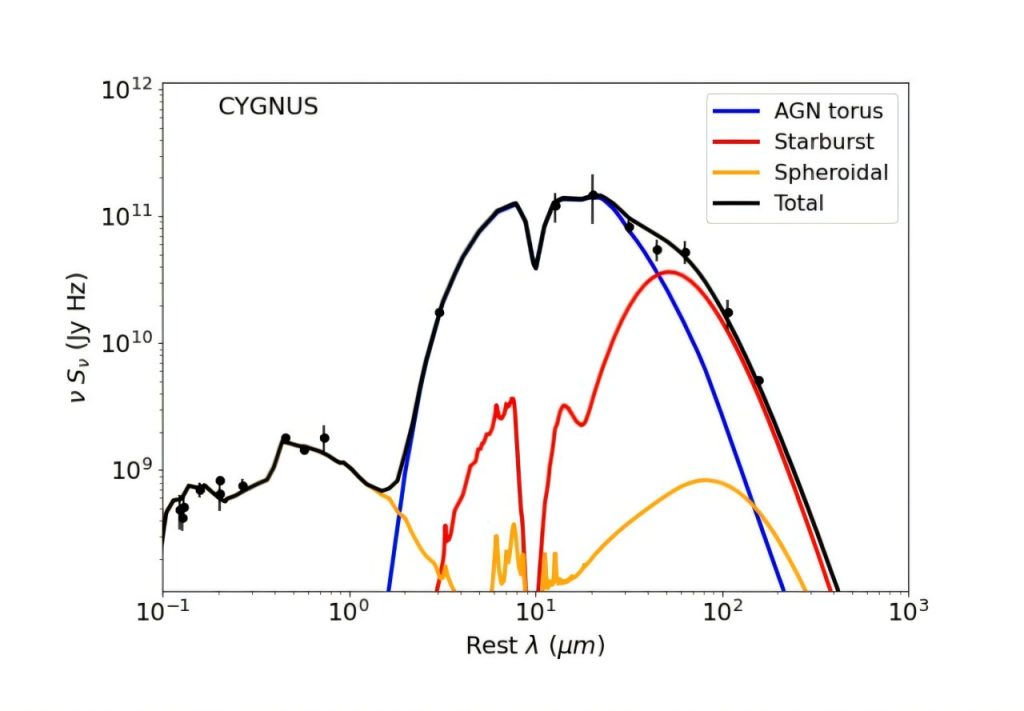
Astronomers explore the properties of an obscured hyperluminous quasar (Image Credit: Phys.org)
Astronomers from the European University Cyprus and the University of Hawaii have investigated a recently discovered obscured hyperluminous quasar known as COS-87259. Results of the study, published October 14 in the Monthly Notices of the Royal Astronomical Society, shed more light on the properties of this quasar.
Quasars, or quasi-stellar objects (QSOs), are active galactic nuclei (AGN) of very high luminosity, therefore cores of active galaxies, powered by supermassive black holes (SMBHs), emitting electromagnetic radiation observable in radio, infrared, visible, ultraviolet and X-ray wavelengths.
They are among the brightest and most distant objects in the known universe, and serve as fundamental tools for numerous studies in astrophysics as well as cosmology.
Discovered in late 2022, COS-87259 is a hyperluminous quasar at a redshift of 6.85. The AGN is heavily obscured and has a bolometric luminosity of approximately 50 trillion solar luminosities. Such a high luminosity suggests that this object is powered by an SMBH with a mass of around 1.6 billion solar masses.
All in all, the galaxy is estimated to have a stellar mass of about 170 billion solar masses and its star-formation rate (SFR) was calculated to be at a level of 1,300 solar masses per year.
In order to get more insights into the properties of COS-87259, a team of astronomers led by Charalambia Varnava of the European University Cyprus using their recently developed Bayesian spectral energy distribution (SED) fitting code SMART (Spectral energy distributions Markov chain Analysis with Radiative Transfer models).
“Our method allows us to explore the impact of four different AGN torus models and therefore constrain the properties of the obscuring torus, but also quantify the uncertainties in the AGN fraction, black hole mass and SFR of the fitted galaxy,” the researchers explained.
Varnava’s team found that the CYGNUS AGN torus model, with the tapered disk geometry, provides the best fit to the SED of COS-87259. CYGNUS is the CYprus model for Galaxies and their NUclear Spectra collection of radiative transfer models.
This model predicts an AGN fraction for the galaxy that exceeds 85%, and an SFR exceeding 1,980 solar masses per year. Moreover, the predicted bolometric AGN luminosity was calculated to be at a level of 100 trillion solar luminosities, which suggests a black hole mass of about 3.2 billion solar masses. Thus, all these values are higher than previously thought.
According to the authors of the paper, the results imply that the torus in obscured quasars like COS-87259 has a large covering factor and these objects can be at least as numerous as unobscured quasars. They added that it would be very interesting to estimate the space density of such objects in larger fields with good infrared coverage, which will be surveyed by spacecraft like ESA’s Euclid or NASA’s Roman Space Telescope.
More information:
Charalambia Varnava et al., Exploring the properties of the obscured hyperluminous quasar COS-87259 at z = 6.853, Monthly Notices of the Royal Astronomical Society (2024). DOI: 10.1093/mnras/stae2221
Journal information:
Monthly Notices of the Royal Astronomical Society
© 2024 Science X Network





